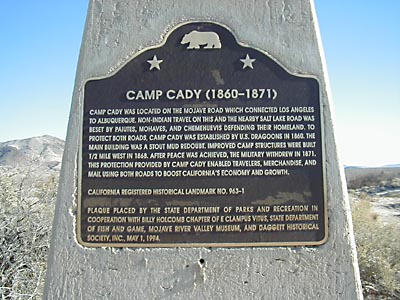NOTE: "Mojave" is generally spelled with a "J" west of the Colorado River, and spelled with an "H" east of the Colorado River. Both are pronounced the same.
Carleton's men had no intention of staying at the spot and were content to live in a scattering of adobe and brush huts, half underground dugout style. There was a central building which could lay some claim to fortress like attributes, a 40-foot adobe square that stood man-high and was surrounded by a ditch.
The Indian depredations finally caused Cady to return to the official orders on July 26, 1864. Captain John C. Cremony and his B Company of the Second California Cavalry were ordered to patrol from Cady to Rock Springs and "to protect travel, clear the road of thieving, troublesome Indians." A year later, the murder of two men 18 miles from the post, and activities of Indians who "come down from the mountains on either side of the road, steal stock, rob houses, lay forced tribute on travelers, threaten lives" forced the reopening of Camp Cady by a company of cavalry.

| B | Barracks |
| COQ | Commanding Officers Quarters |
| GH | Guardhouse |
| K | Kitchen |
| QM & COMM SH | Quartermaster and Commissary Storehouse |